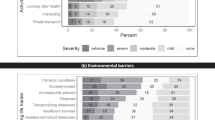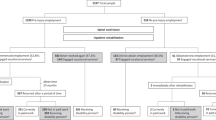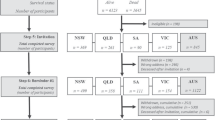Abstract
Study design:
Sequential mixed method design.
Objectives:
Determine factors associated with community participation for individuals with spinal cord injury (SCI).
Setting:
Queensland, Australia.
Methods:
Phase I consisted of a quantitative telephone survey of 270 people who had sustained a SCI within the past 50 years. To verify and interpret survey findings, Phase II involved a qualitative investigation. One focus group, one dyadic and one in-depth interview were conducted with a separate sample of eight people who had sustained a SCI within the past 50 years.
Results:
In Phase I, employment, paid or unpaid, was the strongest independent factor associated with community participation, whereas time since injury, completeness of injury, secondary conditions and functional independence were also independently associated. In Phase II, participants expressed that survey findings were consistent with their lived experiences. They explained that overall, they needed a strong reason to participate so that benefits outweigh the effort required to participate. Once out in the community, they recognised that other opportunities for participation arise.
Conclusion:
Rehabilitation services need to support individuals with SCI to find meaningful employment and to engage in activities that provide them with a strong reason to participate.
Similar content being viewed by others
Log in or create a free account to read this content
Gain free access to this article, as well as selected content from this journal and more on nature.com
or
References
Pershouse KJ, Barker RN, Kendall MB, Buettner PG, Kuipers P, Schuurs SB et al. Investigating changes in quality of life and function along the lifespan for people with spinal cord injury. Arch Phys Med Rehabil 2012; 93: 413–419.
Barker RN, Kendall MD, Amsters DI, Pershouse KJ, Haines TP, Kuipers P . The relationship between quality of life and disability across the lifespan for people with spinal cord injury. Spinal Cord 2008; 47: 149–155.
Gomara-Toldra N, Sliwinski M, Dijkers MP . Physical therapy after spinal cord injury: a systematic review of treatments focused on participation. J Spinal Cord Med 2014; 37: 371–379.
Barclay L, McDonald R, Lentin P, Bourke-Taylor H . Facilitators and barriers to social and community participation following spinal cord injury. Aust Occup Ther J 2016; 63: 19–28.
Reinhardt JD, Ballert C, Brinkhof MW, Post MW . Perceived impact of environmental barriers on participation among people living with spinal cord injury in Switzerland. J Rehabil Med 2016; 48: 210–218.
Barclay L, McDonald R, Lentin P . Social and community participation following spinal cord injury: a critical review. Int J Rehabil Res 2015; 38: 1–19.
Sekaran P, Vijayakumari F, Hariharan R, Zachariah K, Joseph SE, Kumar RK . Community reintegration of spinal cord-injured patients in rural south India. Spinal Cord 2010; 48: 628–632.
Whiteneck G, Meade MA, Dijkers M, Tate DG, Bushnik T, Forchheimer MB . Environmental factors and their role in participation and life satisfaction after spinal cord injury. Arch Phys Med Rehabil 2004; 85: 1793–1803.
Woodruff RE, McMichael T, Butler C . Action on climate change: the health risks of procrastinating. Aust NZ J Public Health 2007; 30: 567–571.
Morgan D, Ataie J, Carder P, Hoffman K . Introducing dyadic interviews as a method for collecting qualitative data. Qual Health Res 2013; 23: 1276–1284.
Addington-Hall J, Walker L, Jones C, Karlsen S, McCarthy M . A randomised controlled trial of postal versus interviewer administration of a questionnaire measuring satisfaction with, and use of, services received in the year before death. J Epidemiol Community Health 1998; 52: 802–807.
McColl MA, Davies D, Carlson P, Johnston J, Minnes P . The community integration measure: development and preliminary validation. Arch Phys Med Rehabil 2001; 82: 429–434.
Weitzenkamp DA, Jones RH, Whiteneck GG, Young DA . Ageing with spinal cord injury: cross sectional and longitudinal effects. Spinal Cord 2001; 39: 301–309.
Seekins T, Clay J, Ravesloot C . A descriptive study of secondary conditions reported by a population of adults with physical disabilities served by three independent living centres in a rural state. J Rehabil Med 1994; 60: 47–51.
Campbell J, Kendall M . Investigating the sustainability of the clinical outcome variables scale (COVS) as a mobility outcome measure in spinal cord injury rehabilitation. Physiother Canada 2003; 55: 135–144.
Masedo A, Hanley M, Jensen M, Ehde D, Cardenas D . Reliability and validity of a self-report FIM (FIM-SR) in persons with amputation or spinal cord injury and chronic pain. Am J Phys Med Rehabil 2005; 84: 167–176.
Pigott T . A review of methods for missing data. Educ Res Eval 2001; 7: 353–383.
Creswell J . Research Design: Qualitative, Quantitative, and Mixed Methods Approaches, 3rd edn (Los Angeles: Sage Publications. 2009).
Song HY . Modeling social reintegration in persons with spinal cord injury. Disabil Rehabil 2005; 27: 131–141.
Leach LS, Butterworth P, Strazdins L, Rodgers B, Broom DH, Olesen SC . The limitations of employment as a tool for social inclusion. BMC Public Health 2010; 10: 621.
Tomassen P, Post MvA F . Return to work after spinal cord injury. Spinal Cord 2000; 38: 51–55.
Hu X, Kaplan S, Dalal R . An examination of blue- versus white-collar workers' conceptualizations of job satisfaction facets. J Voc Behav 2010; 76: 317–325.
Krause J, Terza J, Dismuke C . Earnings among people with spinal cord injury. Arch Phys Med Rehabil 2008; 89: 1474–1481.
Ottomanelli L, Lind L . Review of critical factors related to employment after spinal cord injury: implications for research and vocational services. J Spinal Cord Med 2009; 32: 503–531.
Acknowledgements
We thank the participants for sharing their stories. Financial support for this project was provided by Queensland Health and the Centre of National Research on Disability and Rehabilitation Medicine (CONROD).
Author information
Authors and Affiliations
Corresponding author
Ethics declarations
Competing interests
The authors declare no conflict of interest.
Rights and permissions
About this article
Cite this article
Carr, J., Kendall, M., Amsters, D. et al. Community participation for individuals with spinal cord injury living in Queensland, Australia. Spinal Cord 55, 192–197 (2017). https://doi.org/10.1038/sc.2016.169
Received:
Revised:
Accepted:
Published:
Issue date:
DOI: https://doi.org/10.1038/sc.2016.169
This article is cited by
-
Improving quality of life after spinal cord injury in India with telehealth
Spinal Cord Series and Cases (2019)



